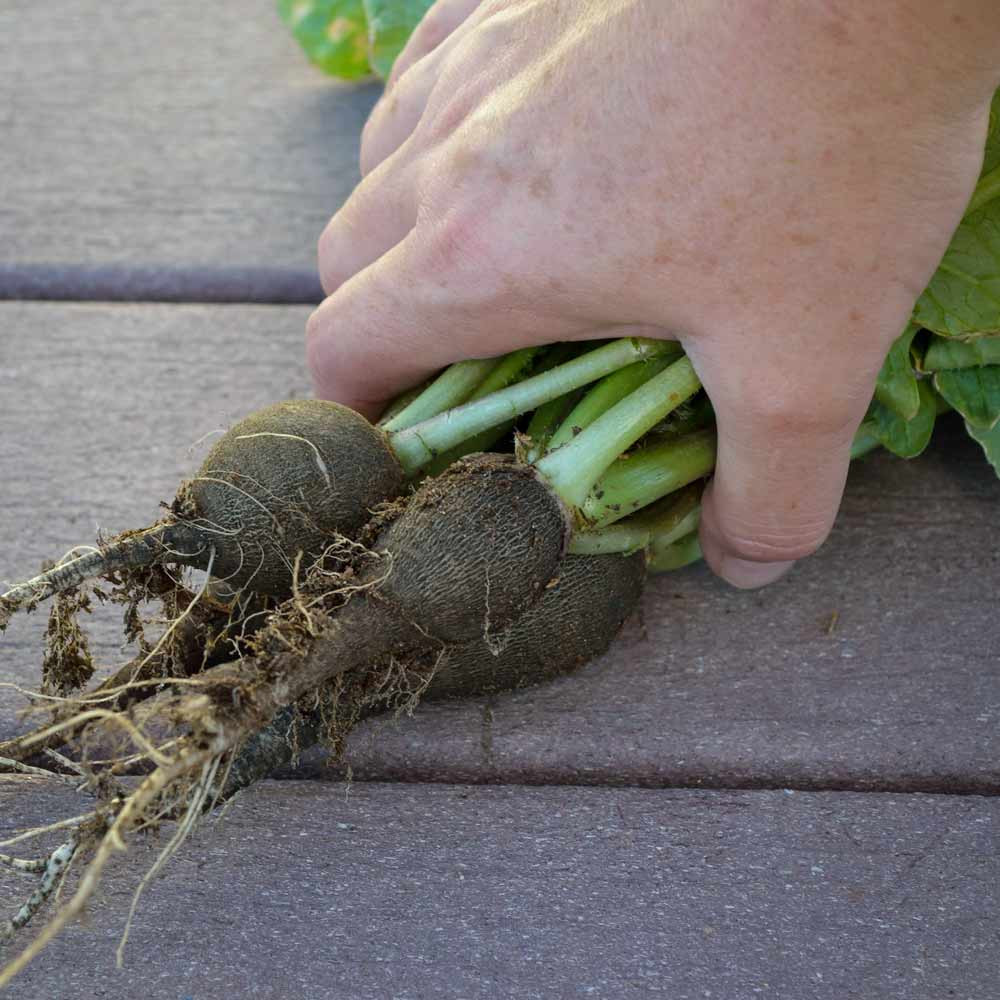Description
Black Spanish Round Radish - The Winter Radish
Very old heirloom radish, grown in Spain since at least the 16th Century and probably long before. It was first introduced around 1824, and is still a very popular choice for a winter radish. Sow in late summer or early fall. They will keep all winter stored in moist sand.
Details
It has large turnip-shape 3-4” diameter globes, deep black skin, solid crisp spicy pure-white flesh with tall tops that are great for winter storage.
History
Different radish varieties are now broadly distributed around the world, but there are almost no archeological records to help determine their early history and domestication.
Ethnobotanists have tentatively located the origin of Raphanus sativus in Southeast Asia, as this is the only region where truly wild forms have been discovered. India, China, and Central Asia appear to have been secondary centers of domestication.
Radishes enter the historical record in third century BC while Greek and Roman agriculturalists of the first century AD described details of small, large, round, long, mild, and sharp varieties. The radish was one of the first European crops introduced to the Americas by way of Mexico.
Uses
Radishes are used in very different ways around the world. China and Japan prefers to pickle most of their radish crop in brine, like we pickle cucumbers. India grows the rat-tailed radish for its fleshy edible seed pods which reach a length of 8-12”, and in Egypt, one type of radish is grown for its top greens only.
European and American home gardeners enjoy their radishes multiple different ways also. The simplest way is sliced radishes with a sprinkling of salt, while the French add butter which tones down the peppery, spicy radish flavor, turning it into an indulgent treat.
Radishes are often served with Mexican food as a cooling vegetable that helps to cleanse the palate between bites of spicy food. The radish most likely made its way into Mexican cuisine through the Spanish arrival in the 16th century. They were one of the few vegetables that grew easily in the New World, quickly becoming a staple in the Mexican diet.
Although we tend to eat only the root whole and raw, the radish offers cooking possibilities.
They sauté beautifully thinly sliced and briefly tossed in a pan of hot oil, then sprinkled with flake salt, giving them a surprisingly deep roasted turnip-like flavor. Or halve them, toss in oil and salt and spread them on the grill alongside carrots and scallions. The smoky heat caramelizes their surface while gently softening their center, bringing out distinct sweetness and subtle flavors that are memorable all on their own.
Slow-roasted radishes are delicious, but another tasty option is pan-braising, which mellows the spice and softens its texture, making it tender and moist, almost beet-like.
Companion Planting
Radishes are helpful companion plants for many garden crops, because their pungent odor deters destructive insect pests like aphids, cucumber beetles, tomato hornworms, squash bugs, and ants.
They are excellent planted as a trap crop on the edges to lure insect pests away from the main crop.
Cucumbers and radishes always seem to thrive when grown together, and radishes also grow well with carrots, catmint, chervil, chives, cilantro/coriander, dill, lettuce, nasturtiums, peas, pumpkins, and turnips.
However, they are antagonistic when growing close to Brussels sprouts, cabbage, cauliflower, grape, hyssop, spinach, and summer savory.
Growing Tip
Radishes are a favorite to sow as soon as the soil can be worked in spring, as they grow easily and rapidly in cool weather – often maturing in 3 weeks from seed.
They should be succession planted every 10 days to 2 weeks from early spring until early summer. For a fall crop start 6-8 weeks before your first expected frost date.
Moderately fertile soil is ideal, lightly amended with aged compost, as too much fertilizer results in heavy leafy growth and stunted roots.
Plant seeds for small radishes ½” deep, spaced 1-2” apart, in rows 6-8” apart. Larger radishes need more space, about 3-4” apart when planting. Taking a little time spacing seeds out when planting saves much more time spent thinning and possibly damaging young, fragile roots later on, and makes weeding simpler and faster. After planting, tamp seeds down lightly into the soil, and water lightly.
The key to crisp, mild radishes is steady soil moisture and regular weeding. Ideal soil moisture is when you can feel the moisture in the soil when you insert your index finger to the first joint, but is slightly dirty when pulled out, not muddy. Keeping young weeds out takes only a couple of minutes per row if done every day or every other day.
Harvest Tip
Harvest radishes as soon as they are mature, if you let them them go too long they will be tough and woody. Early morning harvests will give you the best flavor, while late afternoon harvests will taste a little washed out in comparison.
Experiment a little to see what flavor you like best with your radishes. They will be mildest when harvested at the size of a large marble, and will gain flavor and spiciness as they grow in size.

















